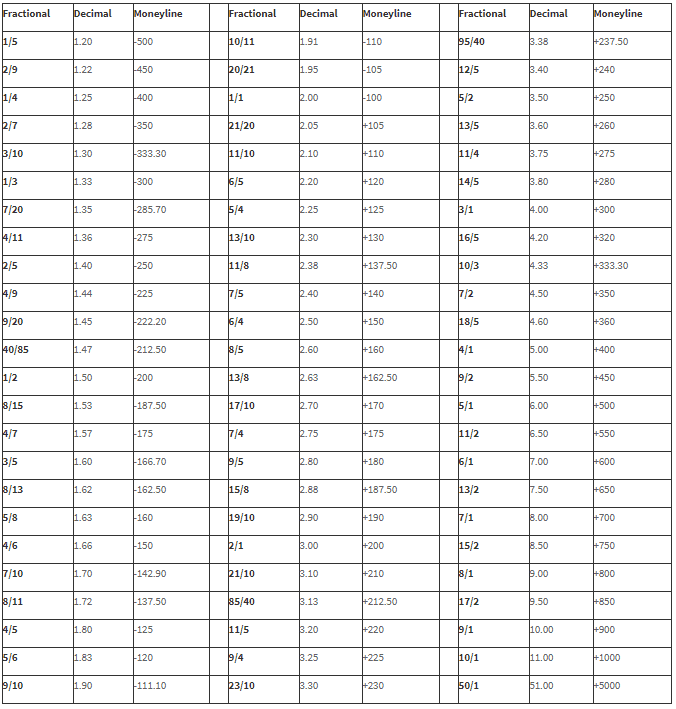Odds Conversion
< Return to betting guide for beginners Go to betting terminology explained >
When it comes to odds - or prices – offered by bookmakers there are three distinct ways in which those odds can be displayed. These are referred to as fractional, decimal and moneyline, with the latter often being called American.
In addition to understanding the difference between the three methods which bookmakers use to calculate and display odds, you can always use odds conversion tables or odds calculators to ensure you have the prices clear in your mind before placing your bet.
Likewise, you can also get a grip on the concept of ‘implied probability’ when assessing odds and shopping for value in the market. We will cover implied probability later in this guide.
Three formats
For the British and Irish they are most familiar with fractional odds, which are displayed as 1/2, 1/1 (evens), 2/1, 100/1 and so on. For Europeans the most common format is decimal, where a price such as 3.00 represents the equivalent of the 2/1 fractional price. In decimal prices the returned stake in a successful bet is ‘built into’ the odds.
Meanwhile, for Americans, in the moneyline format if the figure quoted is positive it expresses the profit you would make from a successful bet with a $100 stake, so 200 means $200 in winnings on top of the returned $100 stake. A 200 moneyline price is therefore the same as the fractional 2/1 odds, or 3.00 in decimals.
Let’s take a more in depth look at each format, with some further examples and comparisons.
Fractional odds
With origins in horse racing fractional odds are by far the most dominant format to express prices in the UK & Ireland. However British and Irish punters are also beginning to become more familiar with decimal odds over time.
Fractions are easy to understand but the format can be somewhat limited to familiar prices, whilst more precise odds are increasingly required by bookmakers and experienced punters. Fractional odds express the profit the bettor will make against their stake, if their bet is correct. So with a 3/1 price if a punter puts down a £10 stake the potential profit is £30 (£10 x 3) and the total that would be returned is £40 (£30 profit plus the £10 returned stake). The same 3/1 price in decimal format would be 4.00 or 4.000 and in the American / moneyline format it would be 300.
When you see prices such as 9/2, 1/1 or 2/7 it is a bit harder to calculate your potential winnings, but not too tricky. With a £10 stake in a successful bet at a price of 9/2 the returns would be £55, a £45 profit plus the £10 stake back. A 9/2 price in decimals is 5.50 and in moneyline it’s +450.
1/1 is also known as evens and is expressed as 2.00 in decimal format, or -100 in American/moneyline odds. Here you could essentially double your money, so if you put down £10, you get £20 back (£10 profit) on a successful wager.
2/7 is an odds against price, meaning there is quite a high probability of winning according to the bookmaker and you will only make a fraction of the stake back in profit. A successful £10 bet at 2/7 returns £2.86 on top of the stake, so total returns of £12.86. This a 1.286 decimal odds price or -350 in American format.
Decimal odds
As widely used in much of Europe and around the world, prices in decimals tell you what you stand to win if your bet is a successful one, including the stake being returned to you. Sometimes decimal prices are quoted to three decimal places, so if you place a €10 stake at 4.755 your total return on a correct bet is exactly €47.55, meaning you made a €37.55 profit.
Although it takes a while to adjust from thinking in fractional odds to decimals they are becoming increasingly popular as they accurately convey to the punter the exact return they stand to walk away with if their selection comes in.
Decimal odds provide purer calculations and are increasingly common on online platforms as bookmakers cater to ever growing international audiences. Decimal odds are also frequently used on betting exchanges.
Follow the patterns of typical decimals odds such as 4.00 (3/1 or +300), 4.50 (7/2 or +350), 5.00 (4/1 or +400), 5.50 (9/2 or +450) and 6.00 (5/1 or +500) and you soon get a feel for how they translate into fractional or moneyline prices. You can always use a bet calculator or an odds conversion table like the one we include below to cross reference prices if you are unsure.
American / Moneyline odds
As you might guess from the name this format is most popular in North America. Again, if the moneyline figure is positive it tells you what you can win on a successful bet with a $100 stake. Remember though, -100 is evens, so your returns are exactly double what you put down. A $100 bet at a price of -100 returns $200, or $100 profit. You bet $100 and you win $100.
With any negative moneyline figure beyond -100 the price is odds against and you stand to make less profit than the stake amount. With -105 moneyline (decimal 1.952 / fractional 20/21) odds your successful bet with a $100 stake win you $95.20 and so you walk away with $195.20 returns. With a -500 price (1.20 decimal or 1/5 fractional) your successful bet with a $100 stake gives you a $20 profit, so $120 total returns. Also, to note, sometimes you will hear prices or odds in North America referred to as ‘lines’.
Odds conversion table
The table below gives you some common prices in the three formats.

Converting odds manually
Punters usually only find themselves in situations where they are trying to convert odds between formats occasionally, for example whilst on holiday or traveling and betting outside their home countries. It is useful to be able to do, if you don’t have a conversion table or tool to hand.
Converting decimal odds to fractional, take the decimal and subtract 1.00, so 5.00 – 1.00 = 4/1. However, it is not always 100% precise if the decimal is not .00 or .000, but you can still do a rough conversion in order to have a sense of the nearest fractional odds. So 4.50 – 1.00 = 3.5/1 or 7/2.
For converting moneyline to decimal, when the moneyline price is positive divide it by 100 and add 1. So = 300 ÷ 100 + 1 = 4.00. Or for example, 5000 ÷ 100 + 1 = 51.00. When the moneyline price is negative, take 100 and divide it by the moneyline amount (first removing the minus sign), and add 1. So for a -400 price it would be 100 ÷ 400 + 1 = 1.25.
For conversion of fractional odds to decimal take the first figure and divide it by the second figure then add 1.00. So 1/2 becomes 1 ÷ 2 + 1.00 = 1.50. Or 2/1 becomes 2 ÷ 1 + 1.00 = 3.00.
Implied Probability
The concept of implied probability is worth keeping in mind when you try to assess the value of odds from a bookmaker. The odds are set based on the implied probability of the outcome, such as a horse winning a race, or a football team winning a league.
A 9/1 (10.00 or +900) bet is ‘expected’ to be successful once in every 10 occasions, so the probability would be 10%. A 1/4 (1.25 or -400) bet would be expected to be successful in four of every five attempts, it is heavily ‘odds on’ and the implied probability is 80%.
You can make these types of calculation to assess the % chance you think your selection has of achieving the result you are betting on and see if you feel the odds are giving you enough value to make the bet.
< Return to betting guide for beginners Go to betting terminology explained >















